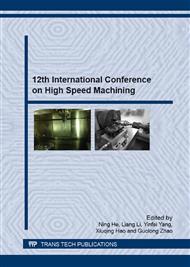[1]
Zhu Zhishou, Research and development of aero structures with new high-performance titanium alloy, J. Aviation science and technology. 01 (2012) 5-9.
Google Scholar
[2]
Ai Xing, High speed machining technology, National Defense Industry, Beijing, (2003).
Google Scholar
[3]
Tan Liang, Zhang Dinghua, Yao Changfeng, Ren Xuejun, Influence of Tool Geometrical Parameters on Milling Force and Surface Integrity in Milling Titanium Alloy,J. 26(2015): 737-742.
DOI: 10.1109/mace.2010.5535284
Google Scholar
[4]
YANG He, FAN XiaoGuang, Recent developments in plastic forming technology of titanium alloys, J. Science China Technological Sciences. 54 (2011) 490-501.
DOI: 10.1007/s11431-010-4206-y
Google Scholar
[5]
Han Rongdi. Metal cutting principle and tool, Harbin Institute of Technology press, (2010).
Google Scholar
[6]
Chen Zhang, Song Guo, Modeling and predicting for surface topography considering tool wear in milling process, J. Int J Adv Manuf Technol . 68 (2013): 2849–2860.
DOI: 10.1007/s00170-013-4989-7
Google Scholar
[7]
Szymon Wojciechowski. The estimation of cutting forces and specific force coefficients during finishing ball end milling of inclined surfaces, J. International Journal of Machine Tools & Manufacture 89 (2015) 110–123.
DOI: 10.1016/j.ijmachtools.2014.10.006
Google Scholar
[8]
JI Wei, LIU Xianli, FAN Mengchao, YOU Haiyan, LI Hanyang, PCBN Tool Wear Characteristic in Cutting Superalloy GH706, J. Tribology. 35 (2015)37-44.
Google Scholar
[9]
GUO Baohui. Research on Wear Behavior of TC4 Alloy at Different Temperatures, J. Heat Process, 44(2015)52-60.
Google Scholar
[10]
LI Anhai, ZHAO Jun, LUO Hanbing, PEI Zhiqiang. Wear Mechanisms of Coated Carbide Tools in High- Speed Dry Milling of Titanium Alloy, J. Tribology. 32(2012)40-47.
Google Scholar
[11]
W. Li, Y.B. Guo, M.E. Barkey, J.B. Jordon,Effect Tool Wear during End Milling on the Surface Integrity and Fatigue Life of Inconel 718, J. Procedia CIRP. 14 ( 2014 ) 546-551.
DOI: 10.1016/j.procir.2014.03.056
Google Scholar
[12]
Yao Changfeng, Zhang Dinghua, Jin Chaoqi, Research on Surface Roughness and Surface Topography of High-Speed MillingTB6 Titanium Alloy, J. Academic papers. 21 (2012)90-93.
Google Scholar
[13]
Harshad A. Somawane, Suhas S, Joshi. Analysis of machined surface quality in a single-pass of ball-end milling on Inconel 718, J. Journal of Manufacturing Process. 14 (2012)257-268.
DOI: 10.1016/j.jmapro.2012.03.003
Google Scholar
[14]
Lu Shihong, Constitutive Modeling and Experimental Study of the Sawtooth Chips in High Speed Cutting (2009).
Google Scholar


